





PHOTO GALLERY

Photos by Len Blumin
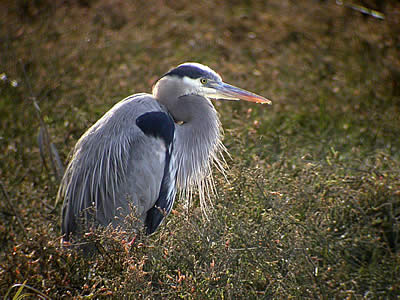
1. Great Blue Heron
The Great Blue Heron (Ardea herodias) is widely distributed in North America, and pretty much everyone in the Bay Area can visit a nesting site, including one at Stow Lake in San Francisco, and of course the rookery at Audubon Canyon Ranch (Marin County, north of San Francisco). These Pterodactyl -like creatures are pictures of grace, whether flying with slow steady wingbeats, or standing statue-like as they wait for prey. The finer feathers on the neck and back are clearly not for flying or for warmth, but aren't we lucky they have evolved as adult breeding plumage features. Back-lighting helps with this species, as in this shot from Shollenberger Marsh in Petaluma (Sonoma County), site of the new headquarters for PRBO (Point Reyes Bird Observatory).
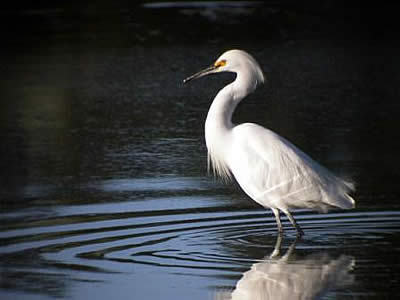
2. Snowy Egret
Bright lighting on the bird darkens the water, sometimes in a pleasing manner. Here the ripples in the water reflect as bright diagonal streaks on the flanks of this Snowy Egret, beginning to show some of his or her breeding finery. The orange lores will get even redder for a brief period at the height of courtship. Bolinas Lagoon (Marin County) north of San Francisco.
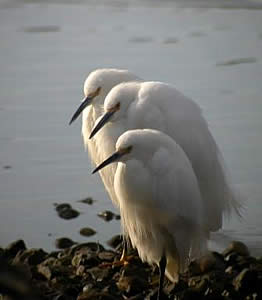
The Snowy Egret (Egretta thula) not only is a communal nester, but they like to hang out with their buddies during the rest of the year, whether fishing in a large group, or just lolling about on the shore. This trio was part of a group at the southern end of Bolinas Lagoon [Marin County], 1995.
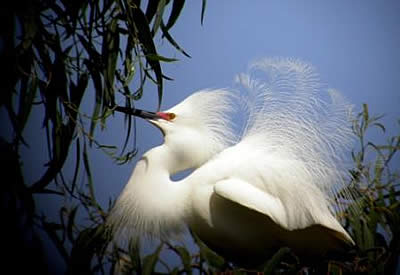
If you've got it, show it! This Snowy Egret has hit the hormonal peak of the breeding season, with the intense red-pink lores complementing the spectacular nuptial plumage, now spead in all its glory. It doesn't get much better than this. From the Santa Rosa 9th Street colony (Sonoma County, north of San Francisco).
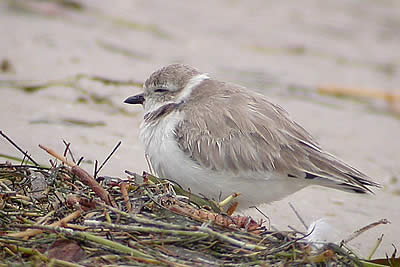
3. Piping Plover
A chilly Piping Plover (Charadrius melodus), fluffed up to keep warm in a brisk breeze along a shoreline near Tarpon Springs, Florida.
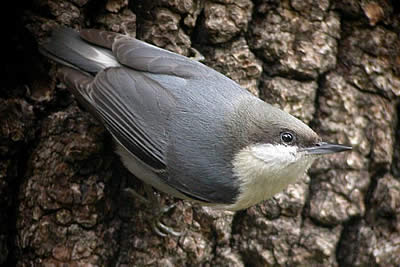
4. Pygmy Nuthatch
We were puzzled when a pair of Pygmy Nuthatches began showing up at our seed feeders, as we usually see these cute birds foraging for insects along the trunks and branches of trees. Well (duh...), the Nuthatch family (Sittidae) is so named for its members' taste for nuts, as least in the fall and winter. They "hatch" or open the nut with their sharp bill, which is also strong enough to chip out a nest hole in a tree trunk. The Pygmy Nuthatch (Sitta pygmaea) is our smallest, at 4.25 inches, and is not found in the eastern states. The short tail is not used to stabilize it as it feeds on the tree trunk. This guy may be small, but he is not shy, and is quick to give the larger juncos a poke to keep them away from the feeder.
The blue-gray back contrasts nicely with the blacker/grayer cap. Some individuals have a more pronounced (darker) eye line that this one. Sorry for the close shot, but the tree is only 20 feet from the house, and I couldn't back up any further!! Adding to the challege was a dark and drizzly day, so the shutter speed was 1/20 sec. These birds do not usually sit still for a photo, but this one sat for over 5 minutes, raising his nictitating membrane several times a second like wind-shield wipers. He never minded my presence, but finally flew at the call of his partner.
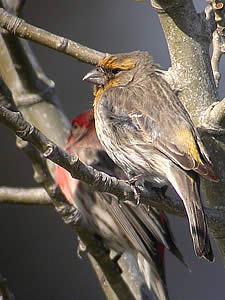
5. Yellow-rumped House Finch
Always a treat to see a tree covered with Houses Finches like so many ornaments, and then "poof" they're gone. These flew before I got get a shot that showed the yellow next to a red, but you can see a red one in the background. Males have the carotenoid pigment, and the more pigment the redder the color. Mostly diet, but maybe other factors (see references, below). These characters were at the Las Gallinas water treatment ponds March 11. Of course the yellow is not really on the rump. Check out that seed-eating bill, which tells you "finch!"
References:
The short story:
http://www.birds.cornell.edu/programs/AllAboutBirds/BirdGuide/House_Finch_dtl.html
The longer story:
http://www.findarticles.com/p/articles/mi_qa3793/is_200110/ai_n8971206
This writer is convniced that other factors (pox molt, mites) can influence pigment and cause
some of the yellow/orange finch colors.
http://www.findarticles.com/p/articles/mi_qa3793/is_200101/ai_n8940452
TOWHEE.NET: Harry Fuller, 820 NW 19th Street, McMinnville, OR 97128
website@towhee.net